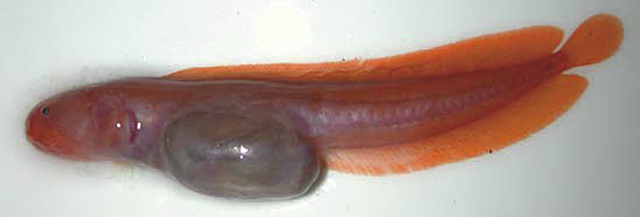| Dinematichthyidae (Viviparous brotula) |
| 3.9 cm SL (male/unsexed); 5.4 cm SL (female) |
|
demersal; marine |
| South Atlantic: South Africa. |
|
Dorsal soft rays (total): 80-86; Anal soft rays: 51-59; Vertebrae: 43-44. The species is characterized by the following: vertebrae 13 + 30-31 = 43-44, dorsal fin rays 80-86, anal fin rays 51-59; snout is terminal to slightly inferior; eye small 1.4-1.6 % SL; pectoral fin length 9.5-9.9 % SL; scales absent on head and body; posterior nostril moderately small, more than half the size of eye; lower preopercular pore 1, small; weak ventral spine on maxilla positioned behind rear of eye; single pair of pseudoclaspers dorsally curved at their distal ends, thin, about half the length of penis (Ref. 57886). |
| A recently caught female specimen from Bird Island, Algoa Bay (SAIAB 70867) was found to be gravid at 54 mm SL with four 20-23 mm SL, fully developed embryos; their preserved coloration is uniformly light brown, slightly darker than their mother (Ref. 57886). |
|
Least Concern (LC); Date assessed: 16 August 2019 Ref. (130435)
|
| harmless |
Source and more info: www.fishbase.org. For personal, classroom, and other internal use only. Not for publication.

